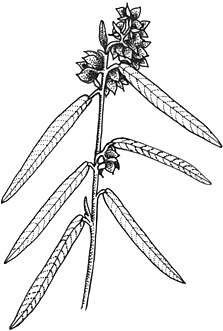Lasiopetalum ferrugineum Sm. ex Andrews APNI* 
Description: Shrub to 1 m high, young branches hoary or rusty-tomentose.
Leaves mostly 2–12 cm long, 5–40 mm wide, ± entire or shallowly sinuate, upper surface glabrous to sparsely pubescent, lower surface white to rusty-tomentose; secondary veins pinnate, sometimes 3–5-veined from base, prominent on both surfaces, impressed above, raised and rusty-coloured below; petiole 2–20 mm long.
Cymes dense, many-flowered, nearly sessile, reflexed; bracteoles linear, 3–5 mm long. Calyx 4–10 mm long, both surfaces hairy.
Capsule 3–5 mm diam., tomentose.
Flowering: spring.
Distribution and occurrence: In eucalypt forest and heath on coast and adjacent ranges.
NSW subdivisions: NC, CC, SC, CT, ST, NWS, CWS
Other Australian states: Vic.
Text by G. J. Harden
Taxon concept:
| | Key to the varieties | |
| 1 | Leaves narrow-elliptic to lanceolate, most leaves <10 mm wide, tapered to petiole or base truncate or lobed. Lamina 3–9 cm long, 5–12 mm wide, margins entire to shallowly lobed or sinuate, apex rounded to acute | var. ferrugineum |
| Leaves ovate to lanceolate, most leaves >10 mm wide, base cordate or lobed. Lamina 2–9 cm long, 8–40 mm wide, margins mostly entire, rarely shallowly sinuate | var. cordatum |
APNI* Provides a link to the Australian Plant Name Index (hosted by the Australian National Botanic Gardens) for comprehensive bibliographic data
***The AVH map option provides a detailed interactive Australia wide distribution map drawn from collections held by all major Australian herbaria participating in the Australian Virtual Herbarium project.
|


